|
|
|
Sort Order |
|
|
|
Items / Page
|
|
|
|
|
|
|
| Srl | Item |
| 1 |
ID:
144703
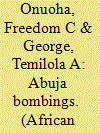

|
|
|
|
|
| Summary/Abstract |
Since his inauguration on 29 May 2015, President Muhammadu Buhari has taken several practical, policy and diplomatic actions aimed at defeating the six-year long insurgency by Boko Haram terrorists in Nigeria. These actions have started to have a modest positive impact on reclaiming the territories previously held by the terrorists. Boko Haram has reacted by ramping up its attacks on soft targets and communities in the north-east. This article focuses on Boko Haram's bombing activities in Nigeria's capital city, Abuja. It shows that between 2011 and 2015, Boko Haram has staged nine bombings in Abuja, resulting in the deaths of at least 191 people, including suicide bombers. It argues that the October 2015 suicide bombings in Kuje and Nyanya, Abuja, represent Boko Haram's bold attempt to respond to President Buhari's counter-insurgency efforts. The article proposes the ‘five Ds’ approach as part of robust measures for combating the insurgency.
|
|
|
|
|
|
|
|
|
|
|
|
|
|
|
|
| 2 |
ID:
113320
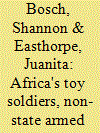

|
|
|
|
|
| Publication |
2012.
|
| Summary/Abstract |
Armed conflict on the African continent has witnessed increasing recruitment of child soldiers, often at the hands of non-state armed groups. Unfortunately this practice continues unabated in the face of legal obligations prohibiting the recruitment of child soldiers under international humanitarian law, and international and regional human rights law. While international condemnation of the practice has led to attempts to increase the minimum age for recruitment to 18, a disjuncture persists between the legal obligations states sign up to, and the actual enforcement of these prohibitions at a domestic level.
International criminal law jurisprudence emanating from the Special Court for Sierra Leone and the International Criminal Court is being monitored closely, as these courts seek to enforce the prohibition in all armed conflicts, and against both state actors and non-state armed groups. International humanitarian law only protects child soldiers who have been unlawfully recruited. In this piece, the authors take a closer look at what amounts to unlawful recruitment in light of customary international humanitarian law, since this body of law also binds non-state actors, even without further criminalising legislation at a domestic level. Moreover, the article briefly explores whether a child can ever void this protected status by volunteering to participate directly in hostilities.
|
|
|
|
|
|
|
|
|
|
|
|
|
|
|
|
| 3 |
ID:
085359


|
|
|
|
|
| Publication |
2009.
|
| Summary/Abstract |
Two concepts, Moskos's institutional-occupational orientations and Meyer and Allen's organizational commitment, were used to develop several hypotheses concerning relationships of soldiers' stated reasons for joining and staying in reserve military service to their stated career intentions and to perceived unit readiness. Survey data were obtained from first-term, junior-ranking enlisted Army National Guard soldiers nationwide at three time periods. Time periods corresponded to different phases of the Iraq conflict- before, during, and after the initial invasion. The number of soldiers at each time period equaled about 7,000 to 8,500. Results suggest material incentives may increase recruitment and retention, yet at the same time, such incentives may not enhance readiness. Rather, incentives fostering normative and affective commitments, such as joining and staying for camaraderie and service to country, were related both to self-reported career intentions and perceived unit readiness.
|
|
|
|
|
|
|
|
|
|
|
|
|
|
|
|
| 4 |
ID:
141170
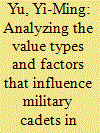

|
|
|
|
|
| Summary/Abstract |
Previous studies have unanimously agreed that despite the challenges of postmodernism, militaries should not and cannot be governed using an occupational model. However, what the notion of the value type of a postmodern army is should be clarified. This study investigates the changing values of postmodern militaries caused by external economic factors. For this research, a questionnaire and long-term investigation method were adopted to collect 262 cadet samples from the Taiwanese military, navy, and air force. The results of a cluster analysis showed that the cadets primarily comprised 3 types, that is, the devotion (DE) type, socially competent (SC) type, and the comfortable (CO) type. This study shows that the socially competent type best satisfies the value demands of the military. In addition, the enlistment motivations of this type of cadet are generally to alleviate family financial burdens, non-economic-related reasons, self-actualization, and patriotism.
|
|
|
|
|
|
|
|
|
|
|
|
|
|
|
|
| 5 |
ID:
173837
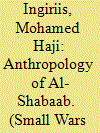

|
|
|
|
|
| Summary/Abstract |
Harakaat Al-Shabaab Al-Mujaahiduun (henceforth Al-Shabaab) is an active insurgent group in southern Somalia battling against the foreign forces and foreign-backed Somali forces. Despite recruiting both in Somalia and in the diaspora, this insurgency movement continues to increasingly recruit more local Somali youth than diaspora Somalis or non-Somalis. This article suggests that Al-Shabaab solicits support from diverse youth who – due to a confluence of factors – join the insurgency movement in various ways. The article reveals how the movement’s methods are flexible insofar as it skilfully recruits both powerful clans and marginalised clans. This pattern tests the limits of the Somali federal government in Mogadishu who have yet to develop innovative approaches to challenge and contain Al-Shabaab. The government failure not only allows Al-Shabaab to successfully carry out its operations but also to sustain itself in the midst of local communities. Through interviews with former Al-Shabaab youth, the article explores youth recruiting efforts and finds that the militant movement pursues various sophisticated means to lure numerous youth into its ranks.
|
|
|
|
|
|
|
|
|
|
|
|
|
|
|
|
| 6 |
ID:
170218
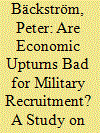

|
|
|
|
|
| Summary/Abstract |
This paper represents the first effort to explore the relationship between civilian labour market conditions and the supply of labour to the military in the all-volunteer environment that Sweden entered after the abolishment of the peacetime draft in 2010. The paper investigates the effect of civilian unemployment on the rate of applications from individuals aged 18–25 to initiate basic military training, using panel data on Swedish counties for the period 2011–2015. A linear fixed-effects model is estimated to investigate the relationship, while controlling for a range of socio-demographic covariates, unobserved heterogeneity on the regional level, as well as aggregate trends on the national level. The results of the panel-data analysis indicate that the unemployment rate has a positive and statistically significant effect on the application rate. These results are robust to non-linear form specifications, as well as allowing the civilian unemployment rate to be endogenous. As such, the results suggest that the civilian labour market environment in Sweden can give rise to non-trivial fluctuations in the supply of applications to initiate basic military training within the Swedish Armed Forces.
|
|
|
|
|
|
|
|
|
|
|
|
|
|
|
|
| 7 |
ID:
187110
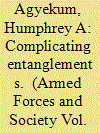

|
|
|
|
|
| Summary/Abstract |
Scholarly debates on civil–military relations often focus on how the military impacts society. Adding to the vast literature of civil–military relations, this article examines how socio-cultural practices and societal developments in the host society affect the military. Based on long-term ethnographic engagement with the Ghana Armed Forces, the piece presents empirical observations of how culturally informed practices, such as begging via proxies (djuan toa), infiltrate the Ghanaian military barracks and affect the institutions’ functioning. The article illustrates how two additional elements, skewed recruitment practices and the politicisation of the rank and file, are used as tools by political factions, such as Ghana’s two most prominent parties (the New Patriotic Party and National Democratic Congress), seeking to gain control over the Ghanaian military. The article analyses how these approaches contribute to undermining the armed forces’ discipline and military professionalism and consequently affect the military institution as a whole.
|
|
|
|
|
|
|
|
|
|
|
|
|
|
|
|
| 8 |
ID:
188055
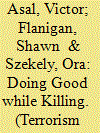

|
|
|
|
|
| Summary/Abstract |
Many nonstate military organizations provide a wide range of social services to civilians. The apparent contradiction between their use of violence and their provision of charity has been the subject of a great deal of research in the conflict studies literature. Two of the most common sets of arguments hold that such services are either a form of bribery aimed at controlling and isolating constituents and potential recruits, or an extension of the organization’s ideological commitments. Our findings, based on a new analysis of the BAAD dataset, demonstrate that neither explanation is correct. Rather, we find that the provision of social services represents a means of confronting and undermining the authority of the state. In this sense, the provision of social services represents an extension of the broader political goals of the nonstate armed groups providing them.
|
|
|
|
|
|
|
|
|
|
|
|
|
|
|
|
| 9 |
ID:
189508
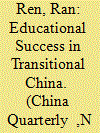

|
|
|
|
|
| Summary/Abstract |
Despite fruitful findings on the reasons underlying the desire for educational success and scarce credentials among students and families, there is little research on the meaning of educational success in the marketplace. As higher education in China has expanded to aid better-quality growth and the transition to a knowledge-based economy, educational success has become increasingly critical in the allocation of socioeconomic rewards. As such, insights into how educational success and concomitant credentials are valorized are empirically and theoretically significant. Drawing on in-depth interviews with 73 recruiters for elite professional service firms, this study analyses the meanings underlying the process of valorizing educational success and elite credentials. It shows that success in the gaokao, or entry to higher education, was qualitatively salient in excluding candidates, while information about subject domains and marks/class rank carried relatively less weight. Recruiters based the value of educational success on the notion of “learning ability,” which reflected their shared understandings about Chinese educational selection/institutions and wider conditions of elite professional firms. On this basis, this paper argues for the development of learning capital as a new theoretical lens for approaching educational success and credentials in transitional China.
|
|
|
|
|
|
|
|
|
|
|
|
|
|
|
|
| 10 |
ID:
020943
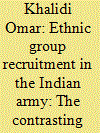

|
|
|
|
|
| Publication |
Winter 2001-02.
|
| Description |
529-552
|
|
|
|
|
|
|
|
|
|
|
|
|
|
|
|
| 11 |
ID:
131091
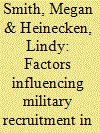

|
|
|
|
|
| Publication |
2014.
|
| Summary/Abstract |
This research sets out to establish how the youth in South Africa view military service, and what factors affect the ability of the South African National Defence Force (SANDF) to attract suitable recruits to staff its modern, technologically advanced military. Due to high levels of youth unemployment, South Africa has sufficient persons volunteering for military service. The problem lies with recruiting sufficient quality personnel with the right profile and abilities. To establish what affects enlistment, focus group discussions were conducted with learners from eight schools to determine what influences their career choices, what deters them from or attracts them to military service, their perception of the military profession, their knowledge of the military, and the influence of factors such as race and gender. The conclusion is reached that the SANDF is not considered an employer of choice due to poor service conditions, a decline in the prestige of the military, unfavourable aspects associated with military culture, a growing 'knowledge gap' and disconnect between the military and South African society, the estrangement of certain race groups, and the masculine nature of the military. These aspects need to be addressed if the SANDF wishes to attract learners with good academic credentials.
|
|
|
|
|
|
|
|
|
|
|
|
|
|
|
|
| 12 |
ID:
089991
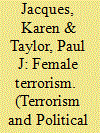

|
|
|
|
|
| Publication |
2009.
|
| Summary/Abstract |
The sharp growth in the number of publications examining female involvement in terrorism has produced a valuable but un-integrated body of knowledge spread across many disciplines. In this paper, we bring together 54 publications on female terrorism and use qualitative and quantitative analyses to examine the range of theoretical and methodological approaches in these papers. Using a content analysis, we identify six primary research foci: Portrayal in media, Feminism, Interviews with terrorists, Group roles, Motivation and recruitment, and Environmental enablers. Results revealed a reliance on secondary rather than primary data, narrative rather than statistical comparisons, and descriptions rather than explanations of events.
|
|
|
|
|
|
|
|
|
|
|
|
|
|
|
|
| 13 |
ID:
127081
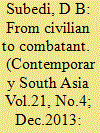

|
|
|
|
|
| Publication |
2013.
|
| Summary/Abstract |
Although combatants played a vital role in the People's War (PW) waged by the Maoists in Nepal, there is a dearth of knowledge about what motivated or compelled people to join the war, as well as what made the Maoists so successful in recruiting and mobilising committed insurgents. Engaging with these questions, this paper aims to understand the causes and drivers of combatant recruitment in the PW. The existing literature demonstrates that armed recruitment and participation in conflict is a phenomenon driven by structural and environmental factors in addition to other conditions, including class-based oppression as well as caste and ethnic grievances. This study, however, contends that in the Nepalese context, while such structural inequalities and disparities created favourable conditions for the PW to escalate, these factors alone cannot sufficiently explain: (a) how and in what ways the Maoists radicalised people or coerced them into becoming combatants and (b) what role the insurgent organisation and the state played in the recruitment dynamics. It argues that an understanding of armed recruitment and participation in the PW should also take into account certain mobilising factors, such as the Maoists' ideology and radicalisation campaigns. Furthermore, it situates the recruitment of combatants within the security paradigm and establishes that the insecurity and violence, caused by both the insurgent organisation and the state, explain voluntary as well as involuntary modes of armed recruitment in the PW.
|
|
|
|
|
|
|
|
|
|
|
|
|
|
|
|
| 14 |
ID:
101437


|
|
|
|
|
| Publication |
2010.
|
| Summary/Abstract |
Community energy initiatives offer a potentially important means for reshaping the electrical system in a manner compatible with emissions reduction goals. Many such initiatives, however, focus upon top-down, institutionally structured approaches that understand community residents as atomistic, economically motivated, and minimally engaged. This paper examines a number of case studies that are based upon a bottom-up approach rooted in a civic culture that seeks to maximize the capacities of an active and engaged citizenry. The paper focuses upon two mutually dependent issues: first, recruiting community members, and second, sustaining their participation.
|
|
|
|
|
|
|
|
|
|
|
|
|
|
|
|
| 15 |
ID:
162521
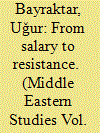

|
|
|
|
|
| Summary/Abstract |
This article traces the military employment patterns of the highlanders of Dibra in the late eighteenth and early nineteenth centuries. It addresses how the Albanian highlanders found different opportunities for military employment in a period largely associated with political instability. The Albanians as ‘mountain bandits’ have been regarded as the primary culprit of the violence that ravaged the Balkans. The same bandits, this article shows, constituted at the same time the irregular forces the Ottoman army came to rely on in the late eighteenth century. By demonstrating different prospects of employment with which the Albanian irregulars were preoccupied, it provides a broader perspective to observe the turmoil the Balkans underwent in a period of political instability. This article also deals with the intricate interplay between the Albanian irregulars and the Ottoman military administration. It reinserts the Albanian bandits-cum-irregulars into the background of the military reforms. Showing how different prospects for military employment that ranged from freelance plunder to service either for the imperial army or the retinue of the rogue Albanian pashas came to clash with the discourse of military reforms, this article also traces the increasing tension between the Albanian irregulars and the modernising Ottoman army.
|
|
|
|
|
|
|
|
|
|
|
|
|
|
|
|
| 16 |
ID:
146574
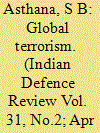

|
|
|
|
|
| Contents |
To flourish a terrorist outfit needs financial and logistics support, political patronage and a
supportive of submissive population, which is the centre of gravity in prospering or combating
terrorism (providing recruitment, intelligence, misguided ideology/religious narrative, media and cyber/technological support). To combat such dangerous terrorist outfits and save innocent population, it is of utmost importance to cut down its support system, its patronage and assistance, sincerely and honestly by every single legitimate power in the world, selective degrading of some organisations such as the ISIS with minimum callateral damages and take onboard some religious leaders, who can support the narrative of peaceful eoexistence for all communities.
|
|
|
|
|
|
|
|
|
|
|
|
|
|
|
|
| 17 |
ID:
119414
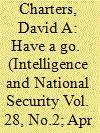

|
|
|
|
|
| Publication |
2013.
|
| Summary/Abstract |
Early in the Northern Ireland conflict the army took the lead in intelligence operations, including Humint. This article examines the case of 'Observer B', an agent run jointly with MI5. Using testimony and documents provided to the Bloody Sunday Inquiry as well as original archival sources, it offers a unique Humint case study that discusses the agent's recruitment, motivation, reliability, handling, product, and utility. This represents the most complete account that we have of this case, but gaps remain. It illustrates some of the limitations of clandestine Humint collection in situations where information may be time-sensitive. The article challenges the conventional wisdom about army/MI5 relations and shows how the two improvised and cooperated in agent-running.
|
|
|
|
|
|
|
|
|
|
|
|
|
|
|
|
| 18 |
ID:
189405
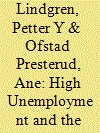

|
|
|
|
|
| Summary/Abstract |
The SARS-CoV-2 pandemic, the subsequent non-pharmaceutical interventions by governments to reduce the transmission of the coronavirus, and adjusted consumer behaviors have resulted in high unemployment rates worldwide. In this paper, we explore whether the Norwegian Armed Forces can exploit this period of high unemployment to strengthen security and defense in Norway while increasing the job opportunities for young individuals in a difficult labor market. Before the pandemic, the Norwegian government had planned to gradually increase the number of personnel in the armed forces. Hence, an expedited recruitment strategy may improve welfare. We calculate the costs and benefits to Norwegian society of a strategy that exploits the hike in unemployment rates to recruit new personnel to the armed forces at a faster rate. We find that the expedited recruitment strategy will likely provide net benefits to society if the unemployed have a fair chance of being employed. However, we stress that there must be a real need for higher defense spending, it is difficult to estimate the economic value of defense production, and there may be a trade-off between the goals of labor market policies and those of defense policies.
|
|
|
|
|
|
|
|
|
|
|
|
|
|
|
|
| 19 |
ID:
044813
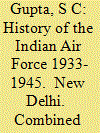

|
|
|
|
|
| Publication |
New Delhi, Combined inter-services historical section, 1961.
|
| Description |
xx, 194p.Hbk
|
|
|
|
|
|
|
|
|
|
|
|
Copies: C:1/I:0,R:0,Q:0
Circulation
| Accession# | Call# | Current Location | Status | Policy | Location |
| 007306 | 940.5425/GUP 007306 | Main | On Shelf | General | |
|
|
|
|
| 20 |
ID:
165193
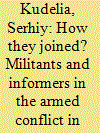

|
|
|
|
|
| Summary/Abstract |
The effectiveness of recruitment strategies is crucial for sustainability of any insurgent campaign. This paper identifies eight mechanisms used to encourage overt and covert participation in the armed conflict in Donbas and shows that they varied depending on the type of service expected from a recruit. It relies on the original dataset compiled from studying 798 court cases of insurgents and informers convicted in Ukrainian courts in the period from October 2014 to March 2017. The paper finds that militants were more responsive to contractual or hierarchical mechanisms of recruitment, while informers who provided cover support were more likely to join through ideological appeals or activation of prior social ties.
|
|
|
|
|
|
|
|
|
|
|
|
|
|
|
|
|
|
|
|
|